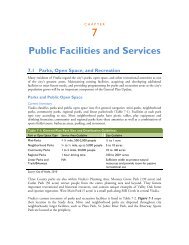General Plan Update Review Committee Draft Elements Part 2 For ...
General Plan Update Review Committee Draft Elements Part 2 For ...
General Plan Update Review Committee Draft Elements Part 2 For ...
You also want an ePaper? Increase the reach of your titles
YUMPU automatically turns print PDFs into web optimized ePapers that Google loves.
<strong>Part</strong>iculate matter in the atmosphere results from<br />
many kinds of dust- and fume-producing industrial and<br />
agricultural operations.<br />
7-4<br />
VISALIA GENERAL PLAN UPDATE<br />
nent damage to lungs. SO 2 is an ingredient in acid<br />
rain, which can damage trees, lakes and property,<br />
and can also reduce visibility.<br />
<strong>Part</strong>iculate Matter<br />
PM-10 and PM-2.5 consist of particulate matter that<br />
is 10 microns or less in diameter and 2.5 microns or<br />
less in diameter, respectively. (A micron is one-millionth<br />
of a meter). PM-10 and PM-2.5 represent fractions<br />
of particulate matter that can be inhaled into<br />
the air passages and the lungs and can cause adverse<br />
health effects. <strong>Part</strong>iculate matter in the atmosphere<br />
results from many kinds of dust- and fume-producing<br />
industrial and agricultural operations, fuel combustion,<br />
and atmospheric photochemical reactions. Some<br />
sources of particulate matter, such as demolition<br />
and construction activities, are more local in nature,<br />
while others, such as vehicular traffic, have a more<br />
regional effect. Very small particles (PM-2.5) of certain<br />
substances (e.g., sulfates and nitrates) can cause<br />
lung damage directly, or can contain adsorbed gases<br />
(e.g., chlorides or ammonium) that may be injurious<br />
to health. <strong>Part</strong>iculates also can damage materials and<br />
reduce visibility.<br />
PM emissions in the <strong>Plan</strong>ning Area are mainly from<br />
urban sources, dust suspended by vehicle traffic and<br />
secondary aerosols formed by reactions in the atmosphere.<br />
<strong>Part</strong>iculate concentrations near residential<br />
sources generally are higher during the winter, when<br />
more fireplaces are in use and meteorological conditions<br />
prevent the dispersion of directly emitted contaminants.<br />
Lead<br />
Paint (houses, cars) and manufacture of lead storage batteries<br />
have been the primary sources of lead released into<br />
the atmosphere. Lead has a range of adverse neurotoxic<br />
health effects for which children are at special risk. Some<br />
lead-containing chemicals cause cancer in animals.<br />
Ambient Air Quality Standards<br />
Regulation of air pollution is achieved through both<br />
national and State ambient air quality standards and<br />
emissions limits for individual sources of air pollutants.<br />
As required by the Federal Clean Air Act, the<br />
EPA has established National Ambient Air Quality<br />
Standards (national standards) to protect public<br />
health and welfare. California has adopted more<br />
stringent ambient air quality standards for most of<br />
the criteria air pollutants (referred to as State Ambient<br />
Air Quality Standards or State standards). In<br />
addition, California has established State ambient air<br />
quality standards for sulfates, hydrogen sulfide, vinyl<br />
chloride, and visibility-reducing particles. Because of<br />
California’s unique meteorological problems, there<br />
are considerable differences between State and federal<br />
standards currently in effect in California, as shown<br />
in Table 7-1. The table also summarizes the related<br />
health effects and principal sources for each pollutant.<br />
The ambient air quality standards are intended to<br />
protect the public health and welfare, and they<br />
incorporate an adequate margin of safety. They are<br />
designed to protect those segments of the public most<br />
susceptible to respiratory distress, known as sensitive<br />
receptors, including asthmatics, the very young,




